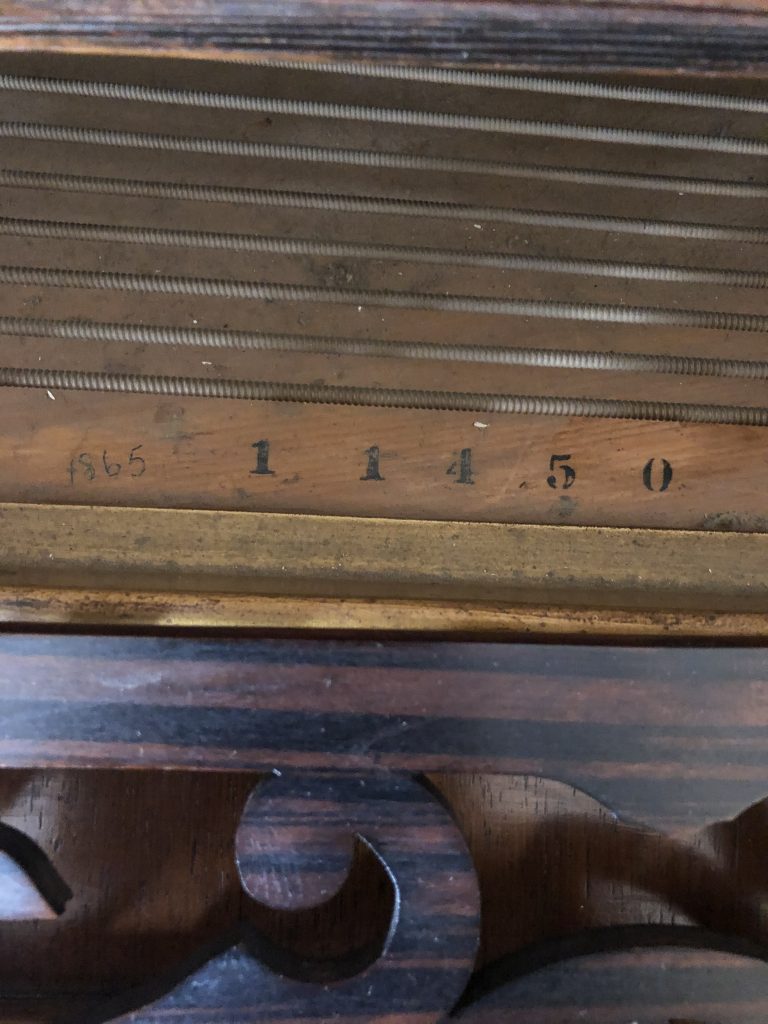My Connection
My Uncle Dave played several instruments including classical guitar, mandolin, violin, trumpet, and piano. His early years were spent traveling with Big Bands in the late 1930s and 1940s. The stories of his travels fascinated me and make me laugh now when I recall them. He gave me my love of music from jazz to classical to folk and delighted in explaining the overlap as well as differences.
I spent a great deal of time with my aunt and uncle while my mother worked. He decided teaching me to play was the ultimate challenge. I have small hands, not conducive to classical piano. His piano was a centerpiece in the main room in their California home. Rule 1 only play with clean hands. Rule 2 practice often. I had a one hour a day regimen after homework with extra on Saturday. It was fun, but my success was limited as a pianist.

This is a view of my son playing October 2021. Before I show those files, I wanted to share a bit of information on this history of this instrument. The Antique Piano Shop in Tennessee provided me the history I’ve included based on the serial number below.
I moved to Texas as an adult and kept in contact with my favorite uncle. When he passed away, I was offered this elegant antique, and it was shipped to Texas by experienced piano shippers. My son, friends, and tuner all played this piano. Now this special instrument needs a new home to share its rich tone when played. It would benefit and increase its value with the right care. If you would like to purchase this piano, leave a comment and I will email you.

AGE: Based on the serial number the piano was built in 1866.
GENERAL INFORMATION: This piano is made of Brazilian Rosewood and is of the carved Rococo Victorian style. Brazilian Rosewood is endangered today and nearly impossible to get in North America. It is very desirable as a result. It appears that someone has removed the original finish from your piano. It would be quite beautiful after professional restoration.
Your piano is one of the highest-grade, most elaborate pianos by Emerson. Your piano has a finished back with rounded corners so that it can be set in the middle of a room; most square pianos have squared-off unfinished backs meant to be set against a wall. Your piano has a 85 note keyboards. A full 88-note keyboard was not standard until closer to 1900. Also, your piano has more carved detail than the lower-grade models. Because of their high cost when new, these top-of-the-line pianos were built in small numbers and are quite rare today! This really is a special piano.
Your piano appears to have had some minor work done but appears to be in original unrestored condition with the old worn strings and interior mechanisms still present. The average piano has about a 50-year life span before it needs restoration, so the fact your piano is in such good condition at this age is a testament to the quality that went into building it 100+ years ago! The piano would need total restoration to be tunable and usable, and to be worth top dollar. It is fascinating to think that with the endangered Brazilian Rosewood and the endangered ivory, your piano could not be built today.
We restore more square grand pianos than anyone in the country. At any given time, we have at least 8 or 10 square pianos in our shop undergoing restoration, as it seems that people are beginning to realize the actual value of these pianos rather than considering them to be “white elephants”.
Additional History
The Victorian Square Grand Piano: These magnificent instruments were once very popular in both America and Europe during the Victorian era. They were produced from about 1850 to about 1880, and were usually hand made with intricately carved rosewood, mahogany, or ebony cabinets. The last known production of square pianos seems to be about 1885 due to the new popularity of the upright piano. Before the upright piano gained its popularity in the late 19th century, the square grand piano was the instrument of choice in most fashionable homes. Although it is quite large and striking in appearance, its tone is very different than contemporary instruments. The square piano sounds reminiscent of the early pianoforte of Mozart’s era with a tone that is best described as having a soft, harp-like quality. This instrument was well suited for small intimate gatherings, which were commonplace among the Victorians. At that time, society was accustomed to the square piano’s delicate tone quality because it had been set as the standard for well over a hundred years. The new and more powerful grand and upright pianos of the 19th century were initially considered harsh and unpleasant to listen to, so the more primitive square piano remained popular with the general public well into the 20th century. Today, society is accustomed to the tone of the conventional piano, so square pianos sound very light and delicate to modern listeners.
Musicians and collectors alike have begun to realize how valuable and historically significant these instruments really are. Most piano tuners, on the other hand, are intimidated by square pianos and frequently advise against investing in their preservation. Because of this sort of attitude among professionals in the piano industry, many people have been given the misconception that “square pianos are white elephants worth only their weight in firewood.
For the past decade, there has been a growing interest in these instruments. This revival of the square piano has caused the demand for these instruments to increase significantly, as well as their value. Since restored square pianos have the potential to be worth thousands of dollars, many collectors consider them to be good investments. Many Victorian homes are either purchasing square pianos or having their heirloom instrument restored to complete their music room or parlor.
Here are some things to consider about your piano: Any piano this old will require total restoration. Pianos are made of materials that tend to deteriorate over time. Felt, leather, and rubber tends to simply break down and rot over the years, making it necessary for these materials to be replaced. When a piano is in tune, there is approximately 17 tons of tension on the strings, and old, worn-out strings just won’t hold it. Most piano tuners don’t like to tune vintage pianos because the strings tend to break under tension. Decades of rust, corrosion and deterioration simply break these strings down over time. Many people approach us with the assumption that their piano just needs a good “tune up” to be in perfect playing condition…that simply isn’t the case! These people are amazed to learn that restoration is almost always necessary on these vintage instruments.
It seems that we are about the only company in the country that specializes in square piano restoration. Square grand piano restoration IS NOT a quick or easy money maker, but rather, a craft that takes a lot of time and attention to detail. Most piano tuners today will tell you that your piano is worthless or impossible to restore simply because they are not willing to invest the time and attention required to restore the special pianos…they prefer to make easier money on more conventional instruments. For instance, we frequently have to make parts for these pianos by hand, as most of these parts are obsolete and no longer available today. Additional information can be found about antique pianos and restorations http://antiquepianoshop.com/square-grand-pianos/ .
If you would like to own this piano, leave a comment and I will reach out.
Related Content:
- None Found




2 replies to "WANTED – New Home for this Emerson Piano"
I’m sharing everywhere, Rox!
Jan, thank you so much for your support. Did you like the playing part?